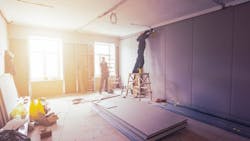New Technologies Improve Acoustic Renovations
Build from scratch or renovate existing space? That’s the question everyone asks when creating an acoustic space. Every studio owner, theatre designer, interior designer and architect has pondered the merits of a purpose-built bespoke space vs. renovating existing spaces.
The preference is usually to start from scratch. A custom-built building has always been the best solution to have complete control over a space’s acoustic isolation and signature performance. However, with rising construction costs and recent advances in technology, the option to renovate is becoming more attractive to designers, owners and managers.
Acoustic renovations are challenging at best. As anyone who’s ever tried a do-it-yourself solution knows that creating an organic, smooth-sounding acoustic signature or isolating a room from abhorrent external noise is far more complex than it appears at first glance.
Challenges in Acoustic Renovations
Isolation has traditionally been and continues to be the hardest acoustic characteristic to create with excellent performance.
To keep all audible frequencies from entering a space, including those pesky low frequency soundwaves, takes more than a couple of layers of 5/8-inch drywall on staggered studs. Planes, trains, cars, motorcycles and music have more low frequency energy than ever before. This means more isolation is required to keep the noise out.
Acoustic signatures have their own challenges. The trend toward healthier building materials has driven many health-conscious clients to steer away from fiberglass-based acoustic absorption and turn toward plant-based recycled materials. They are softer, easier to handle, and as effective as many fiberglass batting solutions. Plus, new technological advances have opened the door for incredibly thin (1 inch) quantum acoustic devices that can control all frequencies.
Acoustical Performance Materials
The real question is: “What type of acoustical performance is right for the space?” As with all types of renovation, the performance and aesthetic are tied to budget and attention to detail. From old-school 4-inch-thick, 6 psi fiberglass or rockwool wrapped in fabric, to new-technology ½-inch-thin recycled cotton absorption panels, acoustic renovations typically have wall-mounted absorption to control high frequency reflections.
However, there’s a new movement in visual acoustics. Across the board, the new trend is high resolution custom imagery printed on high-performance acoustic devices. With it, art and acoustics are blended into one package.
Innovations Aid in Renovations
As for acoustical isolation, 1-inch-thick walls that can soundproof a space are still a few years away, along with the transporter and holodeck. Because of new technology products integrated within innovative designs, a new low-profile 4-inch-thick wall type attached to existing walls achieves the same performance as 18-inch or 24-inch-thick freestanding traditional style wall types.
Acoustics 101: Rejuvenating the Bathroom into a Spa-like Sounding Space
While we’re a visually dominated species, perhaps this combination of art and acoustics will bring us closer to an acoustically pleasant world.
Technology has evened the playing field between renovations and permanent construction. Once upon a time, brick and mortar were the only way to achieve truly effective acoustic performance.
Today, innovative designs mixed with new acoustic devices have created beautiful, ultra-thin, lightweight devices which are affordable and easily to install without the need for permits, contractors or architects.
